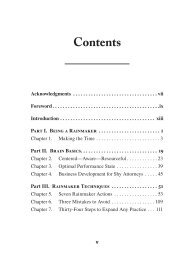(Bk Business) Carol Kinsey Goman Ph.D.-The Nonverbal Advantage_ Secrets and Science of Body Language at Work -Berrett-Koehler Publishers (2008)
Just
Just
You also want an ePaper? Increase the reach of your titles
YUMPU automatically turns print PDFs into web optimized ePapers that Google loves.
Chapter 9: Transl<strong>at</strong>ing <strong>Body</strong> <strong>Language</strong> across Cultures<br />
151<br />
One <strong>of</strong> the challenges for someone from a content culture<br />
is to realize the importance th<strong>at</strong> context cultures place<br />
on building <strong>and</strong> maintaining personal rel<strong>at</strong>ionships. Th<strong>at</strong>’s<br />
certainly wh<strong>at</strong> a major in the U.S. Air Force discovered when<br />
he was on assignment in the Middle East: “<strong>The</strong> outgoing<br />
chief took his replacement to meet a key contact. I w<strong>at</strong>ched,<br />
stunned <strong>and</strong> helpless, as the new <strong>of</strong>ficer destroyed in five seconds<br />
wh<strong>at</strong> the incumbent had taken a year to build. Undoubtedly,<br />
the new chief thought he was cre<strong>at</strong>ing the impact <strong>of</strong> a<br />
hard-charging young executive by barging into the contact’s<br />
<strong>of</strong>fice <strong>and</strong> giving him a bone-crushing h<strong>and</strong>shake, but in<br />
reality he was tearing down a delic<strong>at</strong>e rel<strong>at</strong>ionship.”<br />
Here’s another way to look <strong>at</strong> this segment <strong>of</strong> cultural difference:<br />
It’s well known th<strong>at</strong> advanced industrialized n<strong>at</strong>ions<br />
rely heavily on technology <strong>and</strong> emphasize written communic<strong>at</strong>ion<br />
over oral or face-to-face interactions. Certainly the<br />
United St<strong>at</strong>es, Canada, <strong>and</strong> northern Europe exemplify this<br />
trend. But Japan, which also has the l<strong>at</strong>est technologies, still<br />
relies more on face-to-face communic<strong>at</strong>ion. <strong>The</strong> determining<br />
factor may not be the degree <strong>of</strong> industrializ<strong>at</strong>ion but r<strong>at</strong>her<br />
whether the culture is one <strong>of</strong> context or content.<br />
Affective versus Neutral Cultures<br />
With much angry gesturing, an Italian manager referred to<br />
the idea <strong>of</strong> his Dutch counterpart as “crazy.” <strong>The</strong> Dutch manager<br />
replied, “Wh<strong>at</strong> do you mean ‘crazy’? I’ve considered all<br />
the factors, <strong>and</strong> I think this is a viable approach. And calm<br />
down! We need to analyze this, not get sidetracked by emotional<br />
the<strong>at</strong>rics.” At th<strong>at</strong> point the Italian threw up his h<strong>and</strong>s<br />
<strong>and</strong> walked out <strong>of</strong> the meeting.<br />
In intern<strong>at</strong>ional business practices, reason <strong>and</strong> emotion<br />
both play a role. Which <strong>of</strong> these domin<strong>at</strong>es depends<br />
on whether we are affective (readily showing emotions) or<br />
emotionally neutral in our approach. Members <strong>of</strong> neutral




